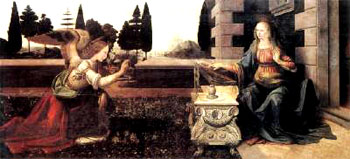Leonardo da Vinci Biography: Florence and Urbino
Early in the year 1500, Leonardo returned to Florence, after an absence of nineteen years. Old lights of art vanished, — Baccio della Porta into a convent, and Lorenzo di Credi under clouds of despair, — and new ones had risen,— Francia, Signorelli, Filippino Lippi, Sandro Botticelli, Perugino; and Michelangelo and Raphael were advancing into fame. But Leonardo was recognized as the foremost of all these, for the renown of his works at Milan had long preceded him. He settled in the city, and shared his house with his old friend, Fra Paciolo, and the beautiful youth, Salai.

Annunciation, 1472-1475
Perugino visited his old comrade at this time, and perhaps led with him his bright pupil, Raphael of Urbino. The youth came under Leonardo's influence, and his pictures of this period strongly reflect the manner of the elder artist. There is a portrait of a young man, in the Uffizi Gallery, which has often been referred to Leonardo's hand; and Bottari is highly of the opinion that this youth was Raphael.
Another artist whom Leonardo often met was Sandro Botticelli, his senior by a few years, and already celebrated for his frescos in the Sistine Chapel. Fra Bartolommeo also came under Leonardo's influence, soon afterwards, and derived the greatest benefit from studying his manner of painting. During this period, between 1503 and 1506, Leonardo painted the exquisitely lovely portrait known as Mona Lisa.
Early in 1503 Leonardo acted on the committee to choose a fitting place for Michelangelo's great statue of David. It was also during this period, in 1502, when Cesar Borgia, the usurping Duke of Romagna and Urbino, who was ambitious of being King of Italy, appointed Leonardo his general engineer, and sent him out to inspect the fortresses in his domains, bearing the following commission : — "Cesar Borgia of France: By the Grace of God, Duke of Romagna and Valentinois, Prince of Adria, and Lord of Piombino: To all our lieutenants, castellans, captains, free-lances, officials, soldiers, and subjects, to whom this notice shall come, we commit and command that to our most skilful and worthy Architect and Engineer-General, Leonardo Vinci, who by our commission is to examine the strong places and fortresses of our States, in order that we may provide for them according to their need and his judgment, they may give free passage and exemption from the public tax-duties, both for him and his company, and that they shall receive him as a friend, and allow him to see, measure, and examine as much as he will. And to this effect let men be summoned to his requisition, and lend him whatever assistance, aid and favor he may wish."
Well compensated and honored by this liberal ruffian, the master made extensive and profitable travels throughout Central Italy, of which he left many notes. In the summer of 1502, he designed new stairways and ramparts to the Citadel of Urbino; and after that time we find him at Pesaro, devising machinery; at Rimini, admiring the music of its fountains; and at Cesena, planning better methods of transporting grapes. He returned to Florence by way of Imola, Faenza, and Forli; and thence undertook an excursion to Chiusi, Perugia, and Foligno, making careful studies of a clock at Siena, and noting the regular cadence of the waves on the sea-shore at Piombino. He probably did something at this time in an art which he had successfully practiced in Lombardy,— that of founding cannon. It appears that Leonardo also painted Borgia's portrait.
Leonardo da Vinci Biography
Leonardo da Vinci in Milan
Leonardo da Vinci - Last years in France